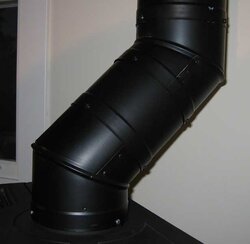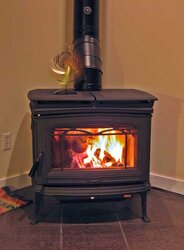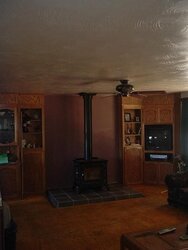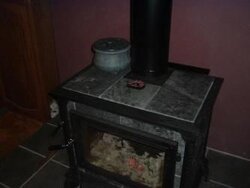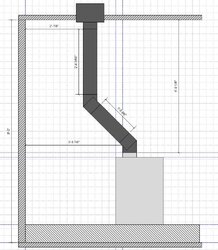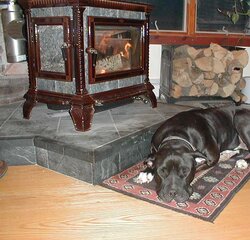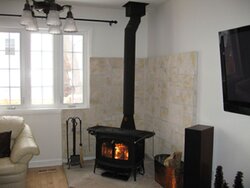Hello all. I have a chimney related question for all of you experts to ponder...
Problem: I am installing a new wood stove and new metal chimney into a 3-year old house. The stove is a Hearthstone Heritage, and the installation will be done by myself and will be in a corner. I have everything planned out for building the raised-hearth pad, building a partial back stone wall with mantel, and now am planning out the chimney. Because of the amount of space that a corner installation takes, my plans call for the stove to be as closest to the wall as possible (following all clearance requirements). So, the real problem, I measured where the chimney is going to go through-the-roof and it is dead-center on a rafter. I've looked into reframing the rafter (done by an engineer) and that just doesn't seem practical. I also looked at putting a bend in the chimney, but it is extremely expensive and there is not a lot of room in my attic to work with (less then 2ft). So, what do I do?
My best solution (so far): I really see 2 options to get around this issue, but I need some expert advice to insure I'm wont be causing issues down the road with a bad draft or cleaning issues or a chimney fire (2 young kids in the house, not taking any chances here!). Option 1: Put a 45 bend + 18" pipe + 45 bend and feed into ceiling support box. This would bring me ~12" away from my rafter, which would put me directly in the middle of my roof rafters! Now, this could cause an aesthetic issue. Option 2: The Heritage supports a rear-flue exit. So, I could put a 45 bend + 14" pipe + 45 bend right out of the stove and then the rest of the stove pipe would be vertical and feed into the ceiling support box. This would also solve my rafter problem, and I believe would be more aesthetically pleasing. BUT, would this cause draft or cleaning issues? Does anyone have any opinions on which option would be better? Any other options someone can think of?
Thank you experts!
Problem: I am installing a new wood stove and new metal chimney into a 3-year old house. The stove is a Hearthstone Heritage, and the installation will be done by myself and will be in a corner. I have everything planned out for building the raised-hearth pad, building a partial back stone wall with mantel, and now am planning out the chimney. Because of the amount of space that a corner installation takes, my plans call for the stove to be as closest to the wall as possible (following all clearance requirements). So, the real problem, I measured where the chimney is going to go through-the-roof and it is dead-center on a rafter. I've looked into reframing the rafter (done by an engineer) and that just doesn't seem practical. I also looked at putting a bend in the chimney, but it is extremely expensive and there is not a lot of room in my attic to work with (less then 2ft). So, what do I do?
My best solution (so far): I really see 2 options to get around this issue, but I need some expert advice to insure I'm wont be causing issues down the road with a bad draft or cleaning issues or a chimney fire (2 young kids in the house, not taking any chances here!). Option 1: Put a 45 bend + 18" pipe + 45 bend and feed into ceiling support box. This would bring me ~12" away from my rafter, which would put me directly in the middle of my roof rafters! Now, this could cause an aesthetic issue. Option 2: The Heritage supports a rear-flue exit. So, I could put a 45 bend + 14" pipe + 45 bend right out of the stove and then the rest of the stove pipe would be vertical and feed into the ceiling support box. This would also solve my rafter problem, and I believe would be more aesthetically pleasing. BUT, would this cause draft or cleaning issues? Does anyone have any opinions on which option would be better? Any other options someone can think of?
Thank you experts!


